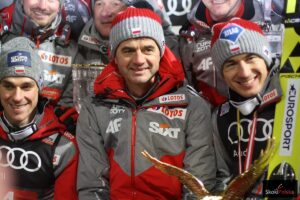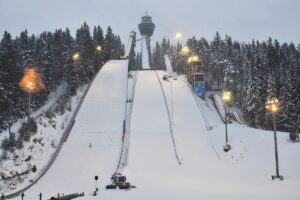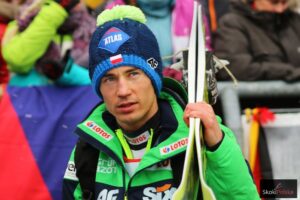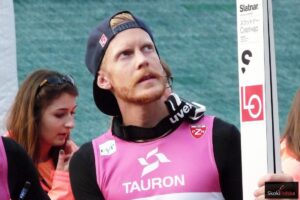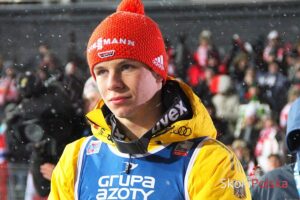The Polish ski jumping team is shaping up for the approaching 2024/2025 season. Some of the athletes have already started training, but the precise composition of the national teams remains a mystery as yet. The head coach of the A team, Thomas Thurnbichler, announced that the ski jumpers will be divided into two groups according to their respective geographical regions. One training group will be based in the Beskidy Mountains and the other will be centered around Zakopane in the Podhale region of Poland. What’s more, three of the most experienced Polish jumpers – Kamil Stoch, Dawid Kubacki, and Piotr Żyła – will train in an individualized manner this season. Keep reading to find out more details!
Bartosz Leja: What will the Polish national ski jumping team look like in the 2024/25 season and when will we find out who will be included in the team?
Thomas Thurnbichler: For now, we are already in training, we’re just waiting for the confirmation from the Ministry of Sport and Tourism. What I can tell you is that the teams are already set up now for the future, to close the generation gap. The goal is still to treat the more experienced guys with an individual plan in such a way that they are still included in the teams, but treated more individually, to keep them at the highest performance level possible.
You said that there would be two groups located in the Beskidy Mountains and Zakopane. What will this division actually look like and who will train both groups as coaches?
For me, it was important to have two main responsible coaches for these two groups. In the Zakopane group, the head coach of this group will be Wojciech Topór and his assistant will be Krzysztof Biegun. They have been cooperating really closely with me in the last two years in the base system, and Wojtek was supporting me last year already during the season from the Four Hills Tournament on. I have a really good relationship with them, they know the system, they know what I’m looking for in ski jumping. I have really good cooperation with them. And in the Beskidy area, I will take the responsibility for the head coach position of this group together with Maciej Maciusiak. All in all, we will have two groups and the goal is then to nominate the best athletes of these groups for the competitions of the Continental Cup and the World Cup. The goal should be that the best athletes will qualify for the competitions. In the World Cup, I will take on that responsibility, and in the Continental Cup it will be Wojtek Topór who will be responsible.
Kamil Stoch expressed his wish to train individually with his own coaching staff. What will his preparations look like and can you confirm that Michal Doležal will take care of his training?
For now, I can’t confirm anything because the framework is not fully clear. The Polish Ski Federation is currently working on this framework process, and because we want to set everything up in the best way for both. We respect the wish from Kamil and the federation will make a decision by the end of the month regarding what this will look like. For now, Kamil is free to train with the people he wants to train with, and if you would like to know what that looks like – you would have to ask the people who are training with him.
Okay, but I suppose he will also spend some time training with your team during the pre-season preparations?
That’s still in planning, so as I said, we will announce what this is going to look like when it’s clear, when it’s decided by the federation. What’s clear is that Kamil Stoch also needs to qualify. I need to see him, and when his performance is at a good level, he will also go to the competitions. And this is what I wish him – I wish him the best and I wish that he will be jumping in the best way until the end of his career.
How did you respond to Kamil Stoch’s request? Did you read it as a lack of trust towards you or not at all?
To be honest, I have no problem with that. It’s Kamil’s decision. It is what it is. It’s not the first athlete who is choosing a way like this and it will for sure not be the last one. So, as I said, I can only respect Kamil’s wish.
I hope it will be like with Adam Małysz and Hannu Lepistö, for example.
Everybody hopes that Kamil will show his best ski jumping and in the end, we will see how it ends. As I said, I wish him the best.
What will be the situation of Dawid Kubacki and Piotr Żyła?
As I said, they will be fully integrated in the team, they just have a little bit of a slimmed down plan, with less traveling, with more efficient camps, so that they will have camps only dedicated for them with all the coaches from the first team. We will have shared camps with the whole team together, so that this contact is also there. And also the trainings in the bases – they will always train with a coach from the respective team. Piotrek also had a wish to train a little bit more at home, so also for these trainings, we have a solution that a coach is with him when he is performing the trainings at home, so it’s really individualized. For these two guys, we have to respect that they are already older, they need a little bit of a calmer preparation than the others. The younger jumpers, they still need to be educated further, they have to do more, they have to learn more – these qualities that Piotrek and Dawid have already. So we need to reduce it to the essentials, to the essential needs for ski jumping, with the clear goal that they go with 100% energy and really fresh into the season 2024/25.
In your opinion, are the trio Stoch, Kubacki, and Żyła – despite their age – able to return to the world’s top ranks and fight for the Crystal Globe? Or will all the jumpers perhaps rather focus on individual challenges, like the World Championships, the Four Hills Tournament.
I wouldn’t look at an overall goal now, like the Crystal Globe. When we go more into the first part of your question – for sure, it’s possible that they can still reach the top. I mean, Piotrek showed that even during a season that was not so good last year, that in single jumps, in single competitions, he can really get close to the best athletes. This is possible. They are great athletes, they have everything it takes. If they go fresh and hungry into the season and if they have worked out the basics and created a solid foundation of consistent ski jumping, then it is possible.
In Planica, some of them told us that they were tired all winter. They said that it was the result of too intense pre-season training suggested by Marc Nölke. What is the plan for the most experienced jumpers for the next season?
As I said, it’s a really efficient plan, so we will go this way – they will only train the basics which are needed, they will have shorter camps, they will have less traveling. Especially the autumn period is for all of the team, but only for the more experienced guys, it will be in Poland, at home, with short, efficient camps, so we can get rid of this tiredness in the beginning of the season, because this was really, as you said, a big problem. It was not only the athletes – also the coaches have been tired. This is what we have to avoid this season. The plan is set up, we’re already training according to this plan. Everybody seems to be really happy about it. Also in individual talks with Piotrek and Dawid, when I showed them their individualized plan, they said it’s a nice plan and they are confident that this plan will work.
You mentioned Maciej Maciusiak, who will be your assistant for this season, but he was removed from the coaching staff last season. What changed for Maciej to return to the coaching staff?
I think that one more time, I have to say that he was not removed. I just told him that I don’t see him as a second team coach and I was asking him what else he could do in the system, and he said that he only wants to do this position. So in this way, it was his decision that he would not be a coach this year. I always said that Maciek is a great coach, he just chose a different way and I didn’t see this great cooperation between the second and the first team. In coaching, we will always have different visions and ideas, and in the last year, we were also in touch, especially in the planning period, and now we’re looking forward to the future. I really see a great match of both our personalities. Maciek is, as I said, a great coach, and I respect him, and I think he respects me. And the first trainings and this whole planning period was really a good match, and I’m just looking forward to this cooperation with Maciek.
Last season, we practically didn’t see any younger jumpers in the World Cup. The youngest regular competitor was the 24-year-old Paweł Wąsek. How can we change this in Poland?
First of all, last year, the quota regulation was certainly not playing into our cards, so what we have to change now is to really focus fully on this young generation. We can see the first change of the system at the junior level – cooperating closely with the schools, having a coordinator head coach, Daniel Kwiatkowski – he’s working really well. I saw these two groups last year in Zakopane and Beskidy in some trainings and I saw a good team spirit and good work, and we also had some good results there at the junior level last season. Now we have also taken some of these guys into the teams, they’re currently making the step into the senior level. We just have to make this transition smooth and find a good educational approach for them to take the next step. It’s important for us to have patience, so that we work clearly on the process they need. This can go a little bit faster for some jumpers and a bit slower for others. But the important thing is patience and really process-oriented work with them.
It is said that ski jumping in Poland is a national sport, but when we look at, for example, hills and young jumpers, there aren’t as many hills and young jumpers in Poland as there are in Austria, Norway, Germany or Slovenia. Do you think that this can be changed? That there should be more small hills in other regions than just Zakopane and Beskidy, for example?
That would be great. I mean, every hill we have, every good working club we could bring into the system would be a benefit. The more jumpers you have, the better it is. But we also have to support the clubs and see all the good work they do. We have a lot of jumpers in Poland. I think it’s not so much a problem of a small number of jumpers, I think we just need to find a good way… What I see is – and it’s not only a Polish thing, it’s also in other nations, also in Austria, we had this problem before we changed things – the problem lies in an exceedingly early specialization of the athletes. So, they are only doing ski jumping training on the ski jumping hills. But to create a really high peak of your performance, you need a wide base. You need to be trained and educated in all necessary movement patterns. You need them. This is something that is not so easy because in families nowadays, usually both parents are working and it’s not so easy to bring the children to several clubs. So, you choose one, and the club is then ski jumping. And in ski jumping, the coaches often have jobs besides coaching, so they also are probably limited to just two or three or four trainings in a week, and then they also choose the way of working – they go to the ski jumps. And I think what is really important is that they learn way more of movement at a young age, and then it’s easier to create this performance level when they are older.
As we know, coach Harald Rodlauer resigned as the coach of the Polish women’s team. Following the example of Norwegians, do you think that it is possible for the men’s and women’s teams to train together to improve the level of the Polish ladies?
I think that last year we already had a good exchange with Harald. We tried to support them, especially throughout the competitions with all service guys, technicians, and so on. But the problem is always that when you train with groups that are too big, the quality of the training is just decreasing. The whole work environment is not calm and efficient, it’s often crowded and messy. So at this point, we have to be really careful. We will surely support them. For example, for now, I’m now also in touch with Stefan Hula, who has now made the step into coaching. He is often asking questions, so we have more of an exchange on what would be needed, and a work exchange. But to connect two groups really closely – I think this is not a way we can go in because the quality of the trainings for both groups would just decrease.
What are your future plans in terms of staying in Poland as a national team coach? Is the goal the Olympic games in Italy in 2026? Or do the plans go much further?
To be honest, I feel really good in Poland. I moved here, I have a wonderful girlfriend. I will become a father, I just moved into a new apartment. So as long as I can help Poland and also the federation sees it that way, I will be ready to work for Poland. So, for sure, my plan is for the Olympics. I could also think about staying here longer.
What are the upcoming training plans of the national teams? When and where will you jump?
We will start jumping with the younger guys already on the 15th of May in Poland. And we then we also have a second camp in Poland. And in the middle of June, we will be in Stams. After this Stams camp in June, we will go to Stockholm for the first time, to the wind tunnel. So, this is the first period. For now, we are working really stabilization-centered in the strength training to get rid of our balance problems and problems in the inrun position, so this is the first main topic we are working on. It’s a pretty similar approach as two years ago. This is the solid foundation we need. We need to have the inrun position clear and stable, and then also this consistent ski jumping is way easier.
You must have seen Ryōyū Kobayashi’s jump of almost 300 meters in Iceland. Are you a supporter of such events and would you allow your athletes to do something like that?
As long as the FIS – the International Ski Federation – is not setting any limits there and is not limiting jumpers, I would see no problem, the Polish ski jumpers could do that. I think especially the avid ski fliers, they would be really happy. Olek immediately sent me the video when he saw it, so I would be open to that. But in the end, it’s a Red Bull project, so it was an effort that was fully dedicated to Ryōyū Kobayashi, and it’s great to see that the limits are further than most people thought. So it looks like even with almost 300-meter jumps, it’s working, the system stays stable, and it’s doable. So, I also think this is something that the FIS will see now and hopefully we will also see slightly bigger hills in the future.
Do you think there is any limit to the longest jump? 300, 400 meters? What do you think?
I think with really great ski fliers… There’s definitely always a limit somewhere, but I think a lot is possible. The problem is, I think, more that only a handful of ski jumpers are capable of really going even further. I think some athletes who already struggle on the ski flying hill will have problems then, but the best of the best – it’s possible for them to go further. But as we know, with every kilometer per hour faster, the air resistance is growing exponentially, so a certain limit is bound to come. For now, we have a really stable system with all the equipment development in the last years, so we see that 291 m is possible… I can’t tell you where the limit is. But if we make small steps towards the limit, we will find it out.
Bartosz Leja, Anna Libera




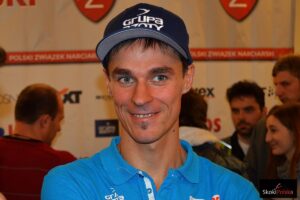

![Read more about the article PŚ Lahti: Tschofenig wygrywa kwalifikacje, Stoch czwarty. Groźny upadek Østvolda [WIDEO]](https://skokipolska.pl/wp-content/uploads/2023/01/Daniel-Tschofenig-fotJulia-Piatkowska_Zakopane2023-300x200.jpg)


